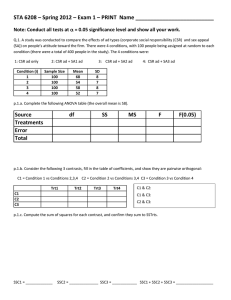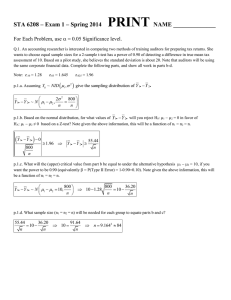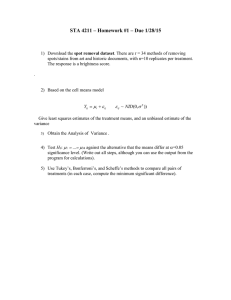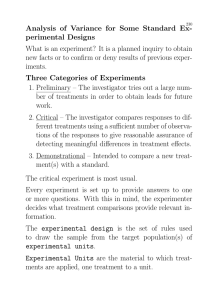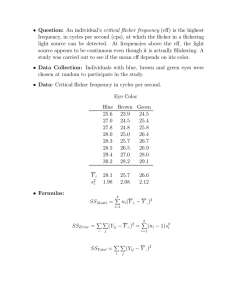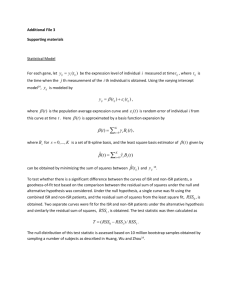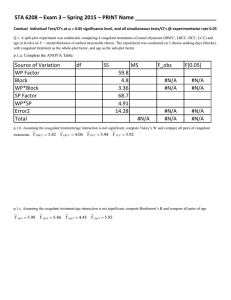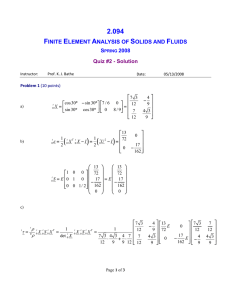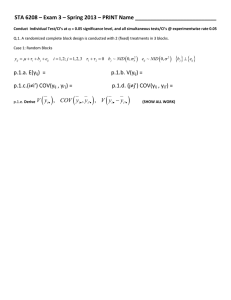STA 6208 – Spring 2011 – Exam 1 ...
advertisement
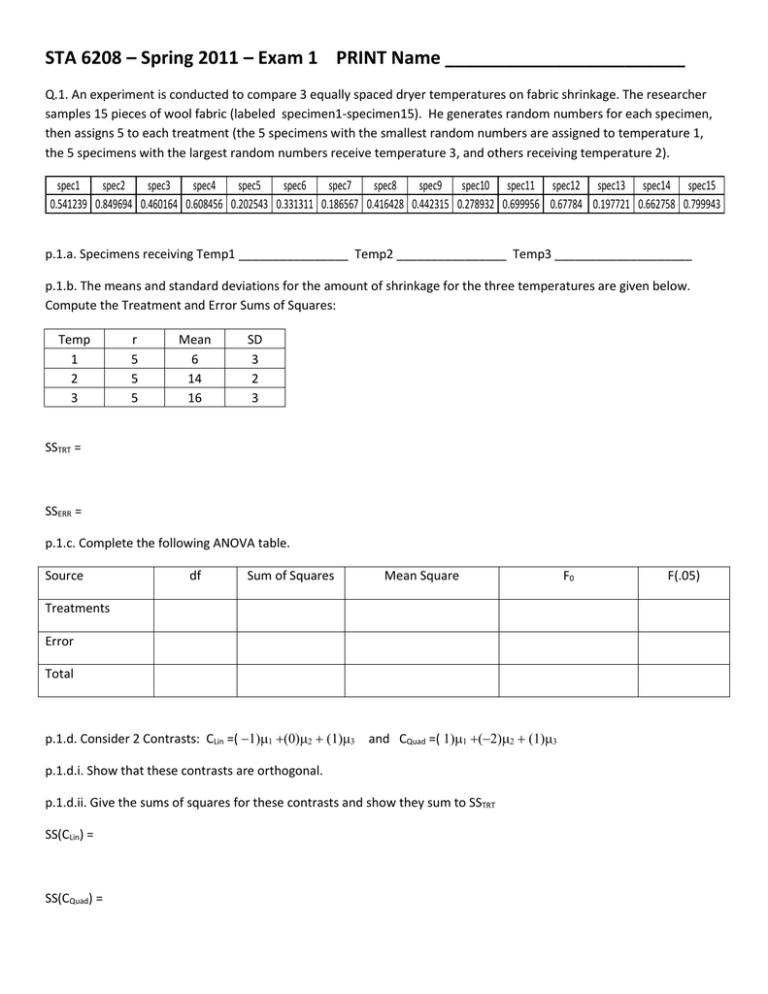
STA 6208 – Spring 2011 – Exam 1 PRINT Name ________________________ Q.1. An experiment is conducted to compare 3 equally spaced dryer temperatures on fabric shrinkage. The researcher samples 15 pieces of wool fabric (labeled specimen1-specimen15). He generates random numbers for each specimen, then assigns 5 to each treatment (the 5 specimens with the smallest random numbers are assigned to temperature 1, the 5 specimens with the largest random numbers receive temperature 3, and others receiving temperature 2). spec1 spec2 spec3 spec4 spec5 spec6 spec7 spec8 spec9 spec10 spec11 spec12 spec13 spec14 spec15 0.541239 0.849694 0.460164 0.608456 0.202543 0.331311 0.186567 0.416428 0.442315 0.278932 0.699956 0.67784 0.197721 0.662758 0.799943 p.1.a. Specimens receiving Temp1 ________________ Temp2 ________________ Temp3 ____________________ p.1.b. The means and standard deviations for the amount of shrinkage for the three temperatures are given below. Compute the Treatment and Error Sums of Squares: Temp 1 2 3 r 5 5 5 Mean 6 14 16 SD 3 2 3 SSTRT = SSERR = p.1.c. Complete the following ANOVA table. Source df Sum of Squares Mean Square Treatments Error Total p.1.d. Consider 2 Contrasts: CLin =( and CQuad =( p.1.d.i. Show that these contrasts are orthogonal. p.1.d.ii. Give the sums of squares for these contrasts and show they sum to SSTRT SS(CLin) = SS(CQuad) = F0 F(.05) Q.2. Consider the 1-Way Random Effects Model: yij ai eij i 1,..., t j 1,..., r ai ~ NID 0, a2 eij ~ NID 0, e2 a e p.2.a. Based on rules involving linear functions of RVs, derive the following values: E yij , V yij , V yi , V y , COV yij , yi p.2.b. In a population of individuals, 95% have mean values between 40 and 60. Within individuals, 95% of individual observations lie within 4 units from the individual mean. Compute I, the Intraclass Correlation Q.3. An experimenter has t=8 methods of preparing steel rods from raw steel, and is interested in comparing their mean breaking strengths. She obtains 40 batches of steel, and randomly assigns them, so that batches are used for each method (that is, r=5). Before conducting the experiment, she envisions many potential comparisons (contrasts) among the treatments and decides she will use Scheffe’s method to conduct all her tests concerning the contrasts (with experimentwise error rate of E = 0.05). Suppose here Error Sum of Squares is SSE = 200. How large will a Contrast sum of squares need to be to conclude that the contrast among population means is not equal to 0 (reject the null hypothesis that the contrast is 0)? Q.4.. Compute Tukey’s and Bonferroni’s minimum significant differences (with experimentwise error rates of E = 0.05) when the experiment consists of 5 treatments with, with 4 replicates per treatment and SSE = 400. Q.5. We wish to conduct an experiment to compare t=4 treatments in a CRD. We would like the probability that we (correctly) reject the null hypothesis to be 1- = 0.80 when the test is conducted at = 0.05 and the i are -20,0,0,20 and = 40. p.5.a. What is the non-centrality parameter in this setting when r=4, when r=8? p.5.b. What is the Rejection Region for the test when r=4, when r=8? 0.0 0.1 0.2 0.3 f328 0.4 0.5 0.6 0.7 p.5.c. Identify on the following plot, the rejection region and power of the F-test for the case r=8. The distribution to the “left” is the central F, the distribution to the “right” is the non-central F. 0 5 10 15 f p.5.d. Does it appear that the power has reached .80 for r=8? 20 Q.6. For the CRD with fixed treatment effects: yij i eij i eij y t p.6.a. Show that r i 1 j 1 p.6.c. Derive E(MSERR) p.6.c. Derive E(MSTRT) ij y i y 2 t r i 1 j 1 2 ij t r y i i 1 2 y t and i 1,..., t r i 1 j 1 i y 2 j 1,..., r eij ~ NID 0, 2 t r y i rt y i 1 2 2

